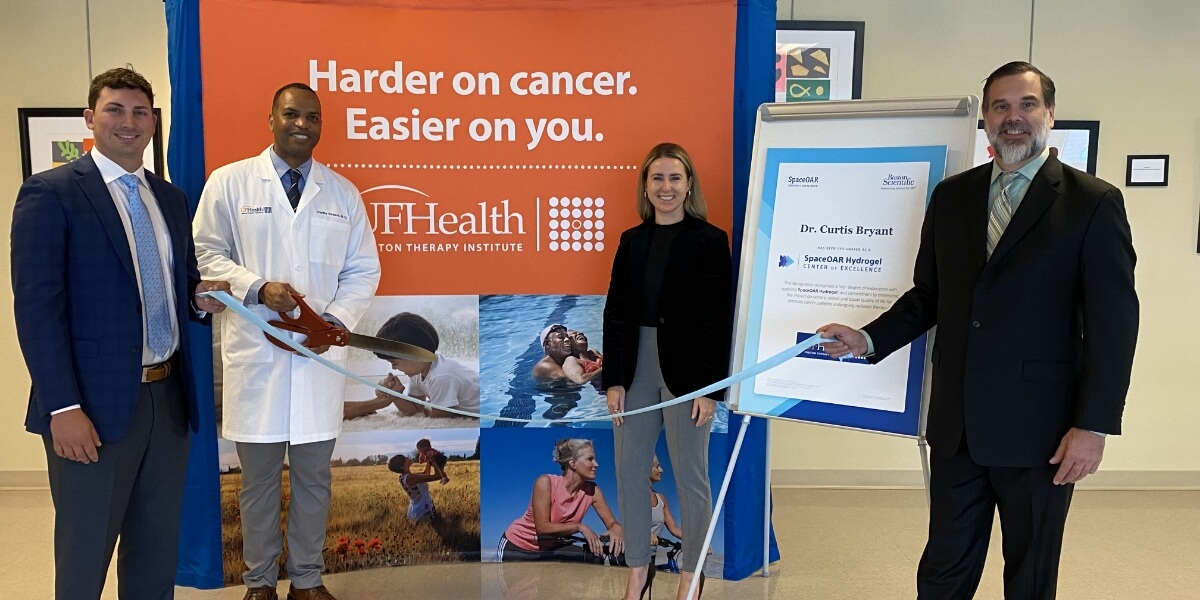UF Health Proton Therapy Institute Recognized as a Center of Excellence for SpaceOAR Hydrogel

The UF Health Proton Therapy Institute earned the designation as a Center of Excellence for SpaceOAR™ Hydrogel.
The award was presented by device maker Boston Scientific in recognition of the superior expertise and experience in placing the SpaceOAR Hydrogel. This perirectal spacer helps to protect the rectum for patients receiving radiation therapy for prostate cancer. Curtis Bryant, MD, MPH, radiation oncologist and associate professor of radiation oncology at the University of Florida College of Medicine, received the award on behalf of the Institute.
The distinction is the first of its kind in Northeast Florida and recognizes a high degree of experience applying SpaceOAR Hydrogel and commitment to patients’ quality of life.
“The UF Health Proton Therapy Institute is committed to improving treatment for cancer patients. Through advancements in radiation like proton therapy, new devices like SpaceOAR Hydrogel, and clinical research, we are seeing excellent patient outcomes,” said Bryant.
Proton radiation for prostate cancer delivers precise doses of radiation with a lower risk of side effects. At the UF Health Proton Therapy Institute the commitment to targeted cancer treatment can be further enhanced using technology like the SpaceOAR Hydrogel in eligible patients.
The UF Health Proton Therapy Institute has used SpaceOAR Hydrogel in over 1,100 eligible patients since FDA approval in 2015. The device is designed to push the rectum away from the prostate, reducing the radiation dose delivered to the organ. Due to the rectum’s proximity to the prostate, it can become unintentionally damaged during radiation treatment. Clinical data has demonstrated the benefits of SpaceOAR Hydrogel, including a reduction in rectal injury, resulting in maintained bowel function and a higher likelihood of maintaining urinary and sexual function. 1, 2
SpaceOAR Hydrogel is made primarily of water and polyethylene glycol (PEG), a compound used in most implants, and naturally leaves the body after approximately six months.3 A physician implants the device during a minimally invasive outpatient procedure, and, typically, patients can go back to normal activities soon after the procedure.
Prostate cancer is the second most diagnosed cancer in American men behind skin cancer, and more than 3.1 million living in the country have been diagnosed with the disease.4 Advancements in treatment for prostate cancer have greatly increased the survivorship rate of the disease. The UF Health Proton Therapy Institute is committed to pursuing research and innovative treatment options/enhancements, like SpaceOAR Hydrogel, to continue on this path.
1 Hamstra DA, Mariados N, Sylvester J, et al. Sexual quality of life following prostate intensity modulated radiation therapy (IMRT) with a rectal/prostate spacer: Secondary analysis of a phase 3 trial. Pract Oncol. 2018 Jan-Feb;8(1):37-315.
2 Hamstra DA, Mariados N, Sylvester J, et al. Continued benefit of rectal separation for prostate radiation therapy: final results of a phase III trial. Int J Radiat Oncol Biol Phys. 2017 Apr 1;97(5):976-85.
3 Boston Scientific. How Does SpaceOAR Hydrogel Work? Available at: https://www.spaceoar.com/about-spaceoar-hydrogel/how-spaceoar-hydrogel-works/. Accessed February 2022.
4 Prostate Cancer Foundation. Treatment for Prostate Cancer: External-Beam Radiation Therapy. Available at: https://www.pcf.org/c/treatment-for-prostate-cancer-external-beam-radiation-therapy/. Accessed February 2022.
